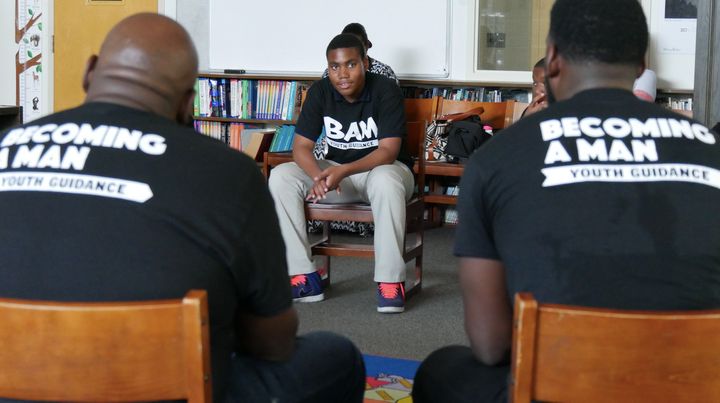
The Chicago-based program Becoming A Man is the type that allows rival gang members to sit together, just days after one group killed a member of the other, and calmly talk about their issues, according to John Wolf, senior manager of the University of Chicago's Crime Lab.
"The kids weren’t saying whether or not they specifically knew who did it. But you had these two groups of people -- where they knew someone from their group of friends had just killed someone from the other group of friends -- and they were able to sit down in this group and have a conversation back and forth about what had just transpired," Wolf said. "They were talking through ways of finding peace and ways of making sure it didn’t escalate further."
For the past few years, Wolf and his colleagues have been studying the impact of the Becoming A Man program, which targets at-risk male students in Chicago public schools. The program, run by the non-profit organization Youth Guidance, allows students to participate in weekly group sessions that teach them how to be more conscious of their decision-making processes. A recent two-year evaluation of the program showed that between 2013 and 2015, there was a 50 percent decline in violent crime arrests for the 2,000 participants as compared to a control group. The results of this evaluation are being shared Monday at the National Summit on Preventing Youth Violence in Baltimore.
By teaching these adolescent males how to slow down their decision-making processes and avoid knee-jerk reactions, the program aims to improve students' abilities to make appropriate judgments in high-stakes situations.
Wolf spent many days observing the participants in the program. He watched as the boys became more willing to open up about their personal lives to other students in the group and speak about their emotional vulnerabilities.
Students in the program often face difficult life circumstances. Many of them live in poverty or in dangerous neighborhoods, surrounded by violence. Just getting to and from school can be a harrowing experience.
Counselors push participants to describe "what are you actually nervous about, what are you actually scared about, what are the things that you're dealing with in your everyday existence, walking home, walking to and from school," Wolf said. "You're not allowed to say that you're fearful or worried about things, but in the BAM circle they're able to uncover those feelings."
"I think a big part of it is, they learn that the kid sitting across from them in the circle has those same fears, has those same anxieties and that it's OK," he went on. "It’s a human condition to show those things and it’s a common experience."
The program does not tell students how to behave, or instruct them as to the "right" thing to do, instead leaving it to the students to decide that. The program emphasizes only that the students carefully consider their decisions instead of rushing to act.
“You're not allowed to say that you're fearful or worried about things, but in the BAM circle they're able to uncover those feelings.”
"BAM providers recognize that these youth live in distressed neighborhoods where being aggressive or even fighting may -- unfortunately -- sometimes be necessary to avoid developing a reputation as someone who is an easy victim," says a 2015 working paper from University of Chicago researchers in the National Bureau of Economic Research.
"It is not hard to see how someone navigating that sort of neighborhood environment could develop a tendency to reflexively push back against being challenged," the paper continues. "That response can lead to trouble if it is over-generalized and sometimes applied in settings where it is not helpful -- such as school."
BAM says its approach is cost-effective: Every dollar invested in the program is projected to return up to $30 in societal gains as a result of crime reduction. Also, because the program increases graduation rates of participants by 19 percent, it will likely produce additional long-term economic gains.
A previous evaluation of the program from researchers in 2009-2010 yielded similarly promising results.
"At a time when Chicago and other cities across the country are seeing increases in violence, this evidence is particularly encouraging,” said Jonathan Guryan, co-director of the University of Chicago Education Lab, in a press release. “Programs like BAM are showing us that it is not too late to help teens in Chicago’s most disadvantaged neighborhoods avoid violence and find success in school.”
______
Rebecca Klein covers the challenges faced in school discipline, school segregation and the achievement gap in K-12 education. In particular, she is drilling down into the programs and innovations that are trying to solve these problems. Tips? Email Rebecca.Klein@huffingtonpost.com.
______
Related Stories:
